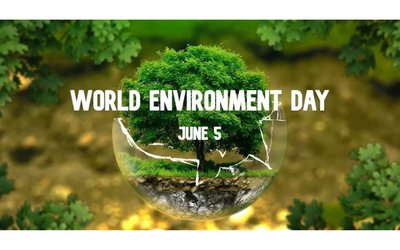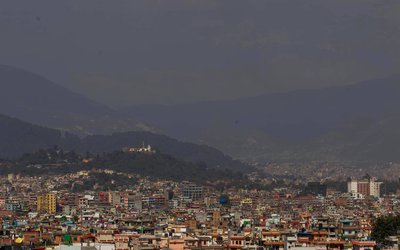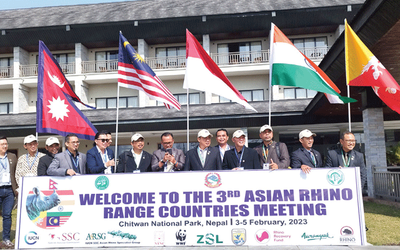In course of development, man has disturbed the global environment. The clear evidence is the current global climate change. For achieving prosperity, man extracted and used fossil fuel to the maximum possible and destroyed a vast forest cover on the earth. As a result, the concentration of greenhouse gases (GHGs) increased in the atmosphere that led to increase the atmospheric temperature, a phenomenon of global warming. On first of August 2019, the World Meteorological Organisation (WMO) issued news that 2019 July has been recorded as the hottest “July” ever since the analysis of climate data was started. A recent UN report titled “Climate Action and Support Trends” has warned that the global surface air temperature will exceed by more than 20 C by end of this century compared to the pre-industrial average if the current rising trend of temperature continues and the global community does not take adequate and necessary actions in time to arrest the trend. The scientists have been warning that such temperature increase will bring irreversible changes in the earth ecosystem which will be beyond the capacity of mankind from responding, coping and adaptation point of view. Least developed countries like Nepal will have to face unprecedented impacts because of lack of capacity.
The current climate change is anthropogenic and its solution lies in mitigation of greenhouse gases through net zero or net negative emissions in to the air in the coming years as a result of development activities and, sequestrating and capturing greenhouse gases that have already been emitted into atmosphere. The developed countries have the biggest responsibilities for it. Nepal has a negligible emission and increase or decrease in the current level of emission by Nepal will have insignificant effect on global GHG emission. However, as a common responsibility, Nepal has to play its roles to the extent it can. This responsibility offers Nepal to opt a new development path way that is “Green Development Path” for its own benefit and to joint hands for global efforts in climate change mitigation.
A development process having a desirable and sustainable growth rate without GHG emission (net zero or negative) and adverse impacts on environment can be said as “Green Development”. It can be achieved by replacing the use of fossil fuels like diesel, petrol, coal, etc. by clean energy sources like hydropower, wind or solar energy, minimizing the use of biomass for energy, and increasing the area and density of the forest and green areas for carbon sequestration and storage. Green development approach will help Nepal to undertake its development by using its own clean energy sources, contribute to global efforts for mitigation of climate change and stop billion of rupees that it pays for importing fossil fuel. The largest portion of Nepal’s GHG emission is from kitchen coming from residential area followed by agriculture and livestock sector. The third major source is use of fossil fuel. The forestry sector has a net negative emission and has contributed to sequestration and storage of CO2 from the air thereby contributing to cleaning the air.
Ministry of Energy, Water Resource and Irrigation (MoEWRI) recently issued information that Nepal purchased electricity worth NPRs23.03 billion from India in fiscal year 2018/19. According to Nepal Oil Corporation (NOC), Nepal imported fossil fuel worth NPRs136.19 billion in 2016/17. The import of fossil fuel is in increasing trend in the following years. These statistics show that Nepal spends significant amount of money on dirty sources of energy from climate change and environmental point of view.
The international trade deficit of Nepal in 2018/19 is over NPRs1.32 trillion which is greater than the revised annual budget of the country of the year. A big portion of this deficit, accounting more than 10%, is contributed by expenditure on import of fossil fuel and electricity.
For the development of a country, there is a need to increase the use of energy. According to information used by National Planning Commission (NPC), the per capita electricity consumption in Nepal has reached to 198kWh a year. This consumption is still below the average of Least Developed Countries (LDCs). In India the per capita consumption is more than 800 kWh per year whereas it has reached to almost 4,000 in China. The electricity generation capacity of Nepal has now reached to around 1,100 MW. At current condition if Nepal has to consume electricity equal to that of India, Nepal will need over 4,400 MW of electricity, and to reach to China’s level, Nepal will need 22,000 MW. To reach to the level of a developed country like Singapore or Switzerland, that Nepal often dreams of, the electricity requirement will be over 44,000 MW which is more than the total technically and economically feasible amount of hydroelectricity of Nepal. Attentions need to be paid to the future projections for energy needs when Nepal exports its electricity based on long term agreement so that Nepal will not deprive of electricity when it needs all its electricity for domestic use.
So there is a huge need of energy for development of the country and Nepal should not depend on and promote the energy from dirty sources like fossil fuel due to economic and environmental reasons. Nepal must promote clean energy that is potential from its own resources like hydropower, wind power, solar power, etc. The clean energy should be used in all the development sectors like industries, factories, transportation, residence, mines and quarries, agriculture, education, health, tourism, construction, etc. to enhance “Green Development”.
For the green development, definitely, Nepal will need to develop technologies, build capacity and skill of its people, bring transformational change in the way of thinking and designing development programmes, restructuring institutions, and develop new economic and financial policies and legislations that help increase investment and harness the benefit from the new approach. But it has to be initiated without lapsing time.

Gehendra B. Gurung
Gurung is a Disaster Risk Reduction and Climate Change Adaptation Specialist. He can be reached at gehendra363@gmail.com
- Localizing Climate Change Actions
- Sep 25, 2019
- Adaptation To Climate Change - From NAPA to NAP
- Mar 04, 2019
- AMCDRR 2018 Declaration: Embracing All DRR Components
- Jul 15, 2018
- Climate Change From NAPA to NAP
- May 03, 2018
















